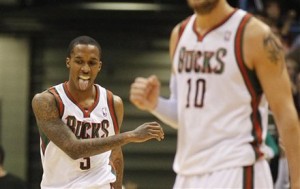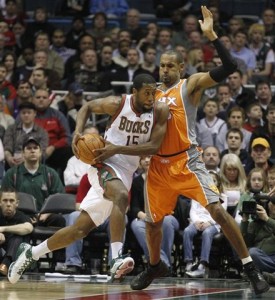
All too often this season, you’ll read Milwaukee Bucks recaps after a loss focusing on a single quarter that effectively killed the Bucks chances at a victory. Unfortunately, Friday night’s 102-88 loss to the Phoenix Suns was no different thanks to a third quarter collapse uglier than that of the 2010 U.S. housing market.
By Jake McCormick
For 36 minutes against the Suns, Milwaukee’s defense suffocated Phoenix’s three point and mid-range attempts, forcing Steve Nash into seven first half turnovers and allowing only high percentage shots inside against the Bucks’ depleted front line of Jon Brockman and Larry Sanders.
But winning three quarters 73-71 quickly turns obsolete when Milwaukee allows Phoenix to explode for a 31-11 third quarter advantage, featuring a 25-6 run headlined by five three pointers off the fingers of four different shooters.
“They’re that kind of team and they can get hot fast,” Bucks coach Scott Skiles said. “They have a lot of great shooters and they have a really good point guard in Steve Nash. He does a great job of conducting that team and he finds spots and gets guys great shots.”
The Suns’ traffic cone defense was certainly challenged in its ineptitude by the Bucks’ hot potato shooting, but Milwaukee looked just as bad as advertised when the game started shifting back in Phoenix’s favor.
Expecting a team to lose from the tip-off is one thing, but the Bucks have a habit of teasing fans with good play for 75-80% of a game before unraveling at the worst possible time.
Milwaukee Bucks starting lineup:
Larry Sanders (10 pts, 5-10 fg, 5 rbs, 1 blk) hit his first three shots, a mid-range jumper, reverse dunk, and tip-in, but finished the game out making two of his next seven shots. Sanders had a few momentary lapses in reason, and his hesitancy, recovery problems on pump fakes, and six fouls are not surprising for a rookie expected to shoulder an increased workload.
Corey Maggette (21 pts, 8-12 fg, 9 rbs) was the best player at the Bucks disposal Friday night, getting to the rim easily on multiple occasions and mixing in the occasional 15 foot jumper. Maggette was definitely a bigger part of the solution than the problem, but he’s spent his whole career being the best player on bad teams, and 2010-11 just pads his resume.
Brandon Jennings started the game with a very Derrick Rose-like stat line (11 pts, 3-8 fg, 5-5 ft in the first quarter), getting in the lane consistently and forcing Steve Nash into five turnovers. But Jennings closed out the game shooting 2-9 and 0-5 on three pointers, making Nash’s seven turnovers, 13 assists, and eight points look enviable in the process.
The good news is that Carlos Delfino shot 50% from beyond the arc. The bad news is that was his only basket out of seven total attempts. Delfino had active defensive hands (5 stls, 9 rbs), but missed every jumper after the 8:24 mark in the first quarter.

John Salmons‘ (6 pts, 2-8 fg, 4 rbs) slashing, spinning, and fade-away jumpers matched up well with the Suns’ indifference towards defense. But Salmons’ 35 minutes of basketball were largely comprised of a disappearing act that would’ve made the Hollow Man proud.
Pessimist: A Cold Steve Nash Outplays Brandon Jennings
Steve Nash didn’t have an impressive game by anyone’s standards, but his 13 assists in 27 minutes were enough to spur the Suns third quarter run and offset his seven turnovers and eight points.
Watching Nash slither around until someone came open along the perimeter did little to fortify hope that Brandon Jennings would one day be capable of finding ways to contribute as a passer when he can’t score.
Jennings’ highest ceiling certainly wouldn’t touch Nash’s, but good NBA point guards need to turn bad shooting nights into quality sharing, and vice versa. Jennings is still very young, and he can’t be blamed for the rest of the team’s missed shots, but he hasn’t been a consistent uplifting presence on the court when he’s needed most.
Optimist: CDR! CDR! CDR!
The only obvious positive to come out of this game was our position in the front row at the end of the Suns bench. Watching Josh Childress munch on an organic Power Bar like a pacifier was the best highlight of the evening.
But you know things are getting bad for a team when a player stuck on the end of the bench (Chris Douglas-Roberts) receives the game’s biggest non-Steve Nash ovation upon entering a lost game. CDR checked in at the 3:56 mark in the fourth after sitting out the previous eight games.
Douglas-Roberts, Brandon Jennings and Larry Sanders are the three players that stand to benefit the most from the Bucks’ current situation. Any minutes for young players, especially when the playoffs are out of the question, prepares them for more meaningful contributions for the next season.
Realist: Issues In The Locker Room
After the game, Milwaukee Magazine’s Howie Magner asked Scott Skiles why consistency has been so hard to find for the Bucks this season. Skiles response:
“That’s not really anything I want to say publicly, if you don’t mind.”
Between Corey Maggette failing his self-administered Bucks experience exam, Chris Douglas-Roberts chuckling upon hearing a question about locker room chemistry, Andrew Bogut’s frustration with a lack of team-wide preparation before games, and Brandon Jennings’ issues with not being the alpha dog every game, Skiles response was not a big surprise.
The 2010-11 Milwaukee Bucks have clear issues on and off the court, and Skiles’ succinct response reinforces the fear that last season was the anomaly in almost a decade of team futility.
Follow Jake on Twitter.